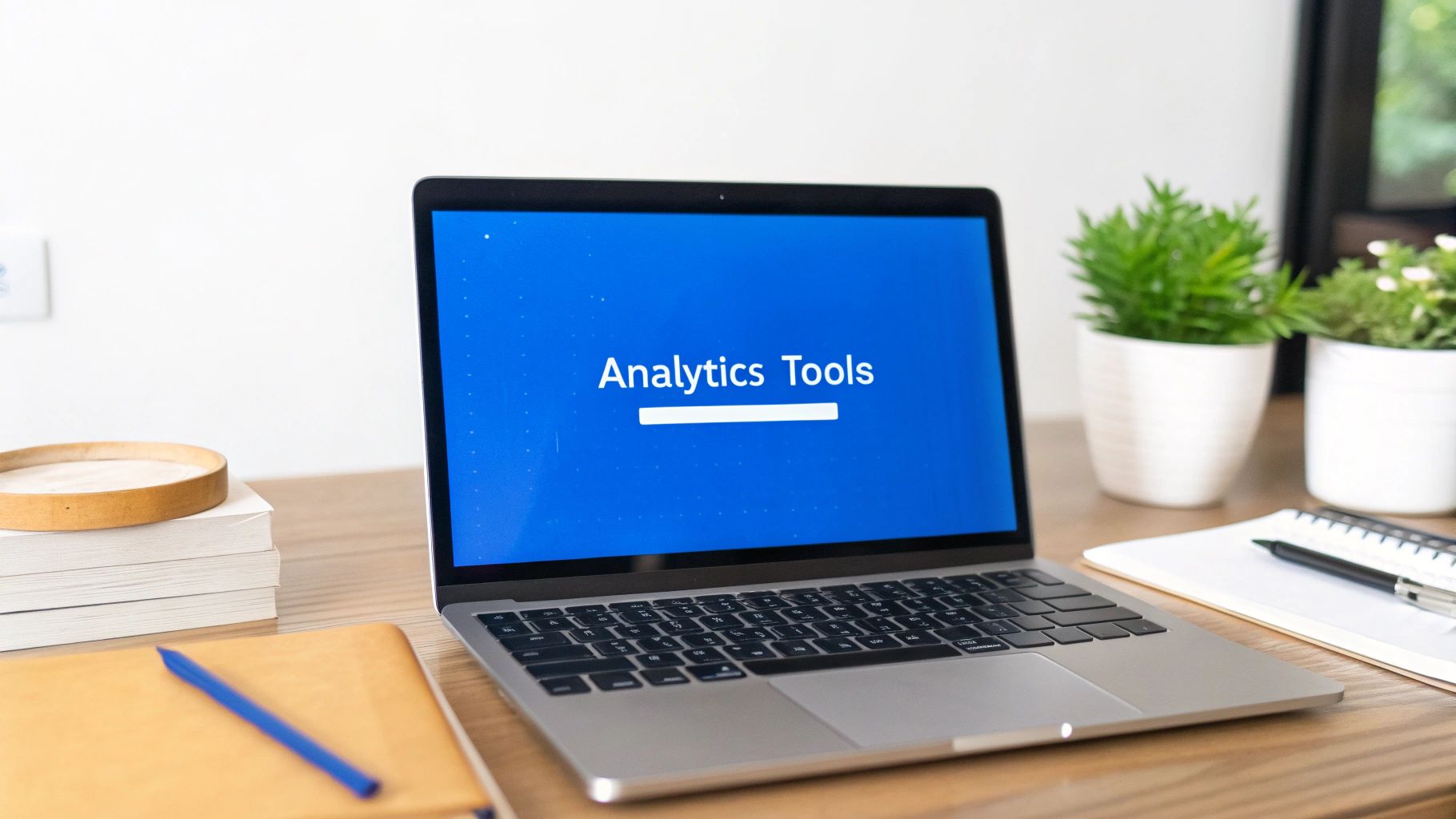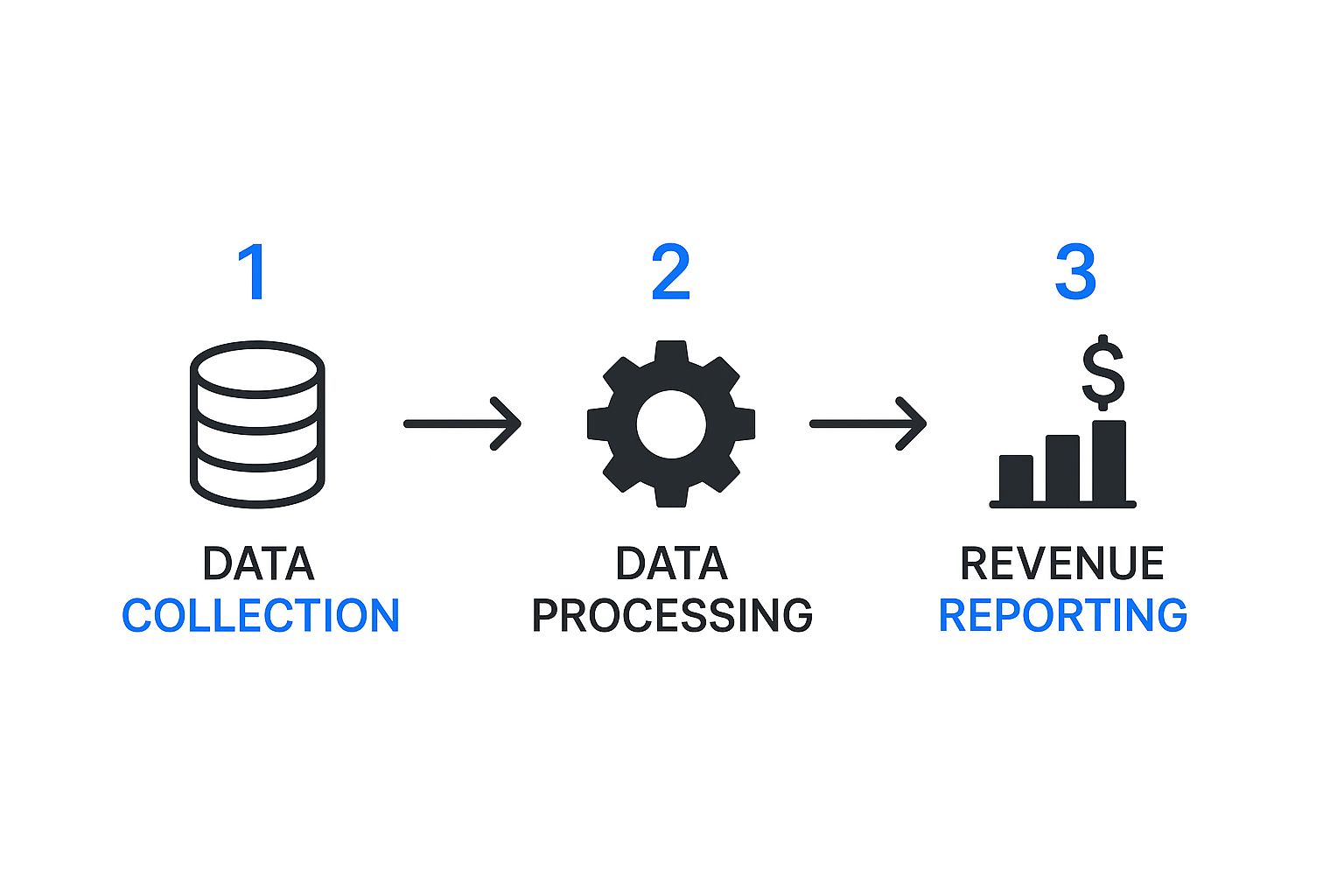Revenue analytics is the engine that connects every decision you make—from a marketing campaign to a product update—directly to your bottom line. It’s the process of collecting, analyzing, and interpreting financial data to truly understand what drives growth and where the leaks are.
This isn’t just about tracking sales numbers after the fact. It’s about turning raw financial data into a strategic roadmap.

Think of your business as a high-performance vehicle. Sales, marketing, and customer success are all critical parts, but without a central diagnostic system, you’re just guessing which components are firing on all cylinders and which are secretly draining fuel.
Revenue analytics is that diagnostic system.
It gives you a unified view of performance by tearing down the data silos that traditionally keep teams apart. Instead of marketing looking at click-through rates while sales obsesses over closed deals, everyone sees the full picture from first touch to final sale. This holistic perspective is the key to making smart, coordinated decisions.
For a long time, financial reporting was a backward-looking exercise—a simple summary of what already happened last month or last quarter. Revenue analytics completely flips that script. It’s about building a proactive, forward-looking growth strategy.
By analyzing current data against historical trends, you can start forecasting future outcomes with far greater accuracy.
The core purpose of revenue analytics is to move beyond simply measuring revenue to actively managing and optimizing it. It's about finding the hidden levers within your business that drive sustainable profitability.
This shift helps you answer the kind of tough, strategic questions that a basic sales report could never touch:
Answering these questions moves your entire operation from reactive to predictive. You’re no longer just responding to the numbers; you're actively shaping them. Our complete guide offers more detail on how a comprehensive analytics strategy can provide these insights.
To put it in perspective, here’s a quick look at how revenue analytics functions across the business.
This table breaks down the key areas where revenue analytics delivers critical insights, helping you see its practical impact on day-to-day operations and long-term strategy.
Core FunctionBusiness Question It AnswersExample ApplicationSales PerformanceWhich sales reps or teams are most effective at closing high-value deals?Identifying top performers' strategies and using them to train the rest of the team.Marketing AttributionWhich campaigns are driving the most qualified leads and actual revenue?Reallocating ad spend from low-ROI channels to high-performing ones.Customer BehaviorWhat actions do our most profitable customers take before they buy or upgrade?Optimizing the user onboarding flow to encourage high-value actions.Product EngagementAre users adopting the features we believe are most valuable?Prioritizing the development of features that are directly tied to customer retention.Financial ForecastingBased on current pipeline and conversion rates, what will our revenue look like next quarter?Making informed decisions about hiring, expansion, and budget allocation.
As you can see, revenue analytics isn’t just a reporting tool—it’s a decision-making framework that connects every part of the business to financial outcomes.
The growing importance of this discipline is clear when you look at the market. Revenue analytics is a key piece of the global business analytics market, which was valued at approximately $285 billion and is on track to hit $320 billion. This boom is fueled by the sheer volume of data modern businesses generate every single day.
Ultimately, embracing revenue analytics means you stop flying blind. It gives every team—from product to finance—the data they need to see their direct contribution to the company's financial health. It’s the essential framework for making smarter, faster, and more profitable decisions, no matter what the market throws at you.
Adopting revenue analytics is like upgrading from a paper map to a satellite GPS. Both might get you to your destination, but one gives you a clear, real-time path, helping you dodge traffic jams and dead ends before you even see them. It turns abstract data into tangible, profit-driving actions.
The true power here isn't buried in spreadsheets; it’s seen in the smarter, faster decisions it fuels across your entire organization. By connecting actions to outcomes, revenue analytics provides a clear framework for sustainable growth.
Without deep analysis, sales teams often treat every lead with the same level of urgency. That's a huge waste of time. Revenue analytics flips the script by identifying the specific traits of deals that are most likely to close and generate the highest lifetime value.
For example, a B2B software company might discover that leads from a specific industry webinar who also downloaded a case study have a 75% higher close rate. This insight is gold. It lets the sales team prioritize their outreach and tailor their pitch, focusing their energy where it will actually make a difference.
This data-driven approach means less time wasted on low-potential leads and more time spent building relationships that directly boost the bottom line. It’s about working smarter, not just harder.
By understanding the 'why' behind successful deals, you can build a repeatable playbook for success. Revenue analytics provides the blueprint by highlighting which customer segments, sales tactics, and product features consistently lead to wins.
Pricing is one of the most powerful levers for growth, but so many businesses set it based on what competitors are doing or what "feels right." Revenue analytics takes the guesswork out of the equation, giving you the data to create a pricing strategy that perfectly aligns with customer value and market demand.
Imagine an e-commerce store digging into its sales data. They might find that customers who buy Product A are highly likely to also buy Product B within 30 days. This insight unlocks a few powerful moves:
This level of detail moves pricing from a guessing game to a strategic advantage, ensuring you capture the most value from every single transaction.
It costs a lot more to acquire a new customer than to keep an existing one. We all know this. Revenue analytics acts as your early warning system, flagging customers who are at risk of churning so you can step in before it's too late.
Think about a subscription-based service. By analyzing usage data, support ticket history, and payment information, the company can create a "health score" for each customer. A customer whose product usage has plummeted and recently had a failed payment? That's a major flight risk.
Armed with this information, the customer success team can reach out with a targeted offer, provide extra support, or simply check in to see what's wrong. This proactive retention strategy is a direct result of connecting behavioral data to revenue outcomes. If you're looking for more ways to connect marketing activities to these outcomes, you can learn about essential strategies in our guide to B2B marketing analytics.
Ultimately, revenue analytics illuminates the direct path from data to profit, turning every department into a more effective engine for growth.

In revenue analytics, it’s incredibly easy to get lost in a sea of acronyms and data points. But here’s the thing: tracking everything is the same as tracking nothing. Real insight comes from zeroing in on the handful of metrics that tell the true story of your business's health and its potential for growth.
Think of these key performance indicators (KPIs) as diagnostic tools. Each one answers a critical question about your business, showing you where to double down on what’s working and what weaknesses need immediate attention.
Let's break down the metrics that actually matter.
Before you can get into the nitty-gritty, you need a solid grasp of your business's core viability. These metrics are the bedrock of any good revenue analytics strategy, giving you a quick, high-level snapshot of your financial performance.
These foundational numbers set the stage, but the real strategic gold is found in the metrics that dig into customer value and how efficiently you’re acquiring them.
Understanding what your customers are worth over time is everything. It's the key to making smart decisions about how much you can actually afford to spend to get them in the door. This is where customer-centric metrics really shine.
Customer Lifetime Value (CLV or LTV) is arguably the most important metric of them all. It’s a prediction of the total revenue your business can expect from a single customer throughout their entire relationship with you. A high CLV is a sign of a healthy business with a loyal customer base that keeps coming back.
Another critical one is Average Revenue Per User (ARPU). You calculate this by dividing your total revenue by the number of users over a specific period. ARPU tells you exactly how much money you're making on a per-customer basis. Watching this metric helps you see if your pricing changes, upsell efforts, or new features are actually increasing the value of your average customer.
Getting customers is expensive. These metrics tell you whether your acquisition efforts are a profitable investment or just a cash-burning machine.
Customer Acquisition Cost (CAC) is the total amount you spend on sales and marketing to land one new customer. This number gives your marketing spend crucial context. A rising CAC might be a red flag that a channel is getting less effective or your messaging just isn't hitting the mark anymore.
The real magic happens when you compare CLV to CAC. The CLV/CAC ratio is a powerful indicator of your business model's long-term health. A ratio greater than 1 means you're making more from customers than you spend to get them, and a 3:1 ratio is often seen as the gold standard.
Net Revenue Retention (NRR) is an absolute must-watch for subscription models. It measures how much your monthly recurring revenue has grown or shrunk from your existing customer base, factoring in upgrades, downgrades, and churn. An NRR over 100% means your business is growing from your current customers alone—a powerful engine for scalable growth without spending a dime on new acquisition.
Finally, you have to be able to trace revenue back to its source. Understanding which campaigns and channels are bringing in your most valuable customers lets you invest your marketing budget with confidence. To learn more about this process, you can explore our guide on how to measure marketing attribution.
By focusing on these core metrics, you can cut through the noise and build a clear, actionable picture of how your company is truly performing.
Jumping into revenue analytics doesn’t mean you need a massive data science team or a six-figure budget. The best approach is a practical one, taking it step by step to connect your data to your decision-making. Building an effective framework is really about turning raw numbers into a clear, strategic story.
The whole process boils down to asking the right questions, gathering the right information, and using the right tools to find answers. You start small, prove the value, and build momentum from there.
At its core, any good revenue analytics framework follows a simple, repeatable loop: you gather your data, process it to make sense, and then report on it to pull out the insights.
This visualization breaks down the basic flow of turning raw data into actionable revenue intelligence.

This fundamental sequence ensures your analysis is built on a solid foundation. It helps you avoid the classic "garbage in, garbage out" problem that plagues so many analytics efforts.
Before you even touch a single data point, you need to know what you're trying to solve. A successful framework always starts with clear, specific questions tied directly to business goals. This is a non-negotiable first step that prevents "analysis paralysis" and keeps your efforts focused on what actually matters.
Start by identifying your biggest revenue-related blind spots. Frame them as direct questions:
These questions become your North Star, guiding every decision you make about data collection and tool selection. Without this clarity from the start, you risk building a system that produces pretty dashboards but no real insights you can act on.
With your key questions defined, the next step is to gather the data needed to answer them. For most businesses, this information is scattered across different platforms, creating data silos that make a complete view impossible. Your goal here is to break down those walls.
The first move is to identify your "single source of truth" for revenue data. For most companies, this is their data warehouse. Having one central, reliable location for all revenue information is absolutely critical for accurate analysis.
From there, you need to connect your most critical systems:
Connecting these sources creates a unified dataset where you can finally see the full customer journey—from the first ad they clicked to their most recent product interaction and subscription payment.
Once your data is flowing into one place, you need the right interface to explore it. The analytics tool you choose should empower your team, not intimidate them. The market is huge, but the right choice really depends on your team's skills, your budget, and the complexity of your questions.
The best analytics tool is the one your team will actually use. An overly complex platform that gathers dust is far less valuable than a simpler tool that fosters a culture of data-driven curiosity.
The demand for these tools is exploding, which just shows how critical data-driven strategy has become. The global data analytics market, a key driver for revenue analytics, was valued at around $28 billion in a recent year and is projected to hit about $72.4 billion within four years. North America is leading the charge, with the U.S. alone making up 75.1% of the region's market share. You can read more about these data analytics market trends to get a sense of just how big this space is getting.
By starting with clear questions, consolidating your data, and picking user-friendly tools, you create a foundation that can scale. This approach ensures your revenue analytics framework delivers immediate value and grows right alongside your business.
Picking the right tool for revenue analytics can feel like a trip to the hardware store for a single screw—the sheer number of options is overwhelming. You’ve got massive all-in-one platforms, hyper-specialized software, and everything in between, each promising to unlock hidden revenue insights.
But here’s the secret: the key isn't finding the tool with the most features. It's about finding the one that actually fits your company's unique needs, budget, and technical skills.
Think of it like choosing a vehicle. A Formula 1 car is an engineering marvel, but it’s completely useless for a family road trip. In the same way, a complex business intelligence (BI) platform is probably overkill for a startup that just needs to connect its sales and marketing data. Your goal is to find the right vehicle for your specific journey.
Most revenue analytics solutions fall into a few key buckets. Getting a handle on these categories is the first step to narrowing your search and focusing on tools that actually make sense for your business.
This screenshot of Salesforce's Sales Cloud dashboard shows how an integrated CRM brings core sales metrics like closed deals and pipeline forecasts into a single view.
The real takeaway here is how these platforms centralize data to give you an immediate, high-level overview of sales performance without needing to juggle external tools.
Instead of getting blinded by flashy feature lists, anchor your evaluation around a few critical, practical questions. The answers will point you to a tool your team will actually use and get value from every single day.
The best revenue analytics tool isn't the most powerful one; it's the one that becomes an indispensable part of your team's daily workflow, making data-driven decisions second nature.
Here are a few non-negotiable points to consider:
The analytics market is exploding to meet this demand. In fact, over a four-year period, the global data analytics market is expected to grow by $288.7 billion, driven by AI and machine learning advancements from over 20 major players like Salesforce and Microsoft. You can discover more about how modern technology is boosting the data analytics market on prnewswire.com.
Choosing wisely means investing in a solution that not only meets today’s needs but is also ready for tomorrow's challenges.

Building a great revenue analytics program is as much about dodging the common landmines as it is about following best practices. Even with the best software in the world, a few critical mistakes can completely derail your efforts, leaving you with flawed insights and a wasted investment. Knowing what these missteps are is the best way to avoid them.
One of the biggest traps is chasing vanity metrics. These are the flashy numbers—like website traffic or social media likes—that look great on a dashboard but have zero direct connection to your bottom line. They might give you a little context, but they won't tell you a thing about profitability or the actual value of your customers.
Instead, you need a relentless focus on metrics that directly tie to revenue. Think Customer Lifetime Value (CLV), Customer Acquisition Cost (CAC), and Net Revenue Retention (NRR). These are the numbers that reveal the true health and staying power of your business model.
Another surefire way to sabotage your analysis is by working with messy, siloed data. When your marketing, sales, and product data all live in separate, disconnected systems, you can never see the full customer journey. That fragmentation makes accurate analysis totally impossible.
The fix is to establish a single source of truth—usually a data warehouse—where information from all your platforms gets consolidated. This creates a clean, unified dataset that lets you trace a customer's path from their very first click to their latest purchase, giving you the complete story of what drives revenue.
Without that unified view, you’re just guessing how different activities impact the bottom line. You'll also struggle with accurate attribution, which is essential for optimizing your marketing spend. To get this right, it's worth understanding the importance of attribution models in marketing.
The goal is to move from isolated reports to a holistic view. When your revenue data is siloed, you get conflicting stories; when it’s unified, you get a single, actionable truth about your business performance.
Finally, one of the biggest mistakes is creating complex dashboards and reports that nobody on the team actually uses or understands. A beautiful chart is useless if it doesn't lead to a smarter decision by a sales manager, marketer, or product lead. Analytics tools are supposed to empower your team, not create a bottleneck.
To get this right, prioritize usability and accessibility when choosing your tools. Make sure you involve the end-users—the people who will be relying on these insights every day—in the selection process.
Stick to these principles to make sure your analytics actually drive action:
By avoiding these common traps, you’ll ensure your investment in revenue analytics delivers on its promise: clear, reliable insights that fuel sustainable growth.
As teams and leaders start digging into revenue analytics, a few common questions always pop up. Getting these cleared up early can demystify the process and give you the confidence to move forward. Here are some straightforward answers to the questions we hear most often.
This is a great question, and the distinction is critical.
Think of sales reporting as looking in the rearview mirror. It’s a snapshot of what already happened—total sales last quarter, deals closed this month, quota attainment. It’s historical, descriptive, and essential for understanding past performance.
Revenue analytics, on the other hand, is like having a GPS with predictive traffic. It doesn't just show you where you've been; it explains why certain routes were faster and forecasts the best path forward to your destination. It connects the dots between sales, marketing, product, and customer success data to diagnose why you're winning or losing and predict what will happen next.
You don't need to hire a team of data scientists right out of the gate. Honestly, the most important "skill" is a healthy dose of business curiosity—a genuine desire to connect your team's daily actions to the company's financial results.
To get started, you'll want people who have:
You can always layer on more technical skills as your analytics practice matures.
The primary requirement for starting with revenue analytics isn't a degree in statistics; it's a commitment to asking "why" and a willingness to let data guide the answers. This shift in mindset is more valuable than any specific technical skill.
This is a common concern, but the good news is that revenue analytics is incredibly scalable. You don't need a massive upfront investment to get started. The key is to start lean and focus on the areas with the biggest potential impact first.
Begin by connecting the tools you’re probably already using, like your CRM (Salesforce, for example) and your payment processor (like Stripe). Many modern analytics platforms offer affordable, entry-level plans designed specifically for smaller teams.
From there, pick one or two critical business questions to answer. Are you trying to identify your most profitable customer segment? Or pinpoint which marketing channel actually drives sales? Focus your initial efforts there. Once you can prove the ROI on a small scale, it becomes much easier to justify more investment as your business grows.
Ready to stop guessing and start knowing exactly which marketing efforts drive your bottom line? Cometly provides a unified platform to track every customer touchpoint, attribute revenue with precision, and get the clear insights you need to scale confidently. Eliminate wasted ad spend and optimize your growth strategy by visiting https://www.cometly.com to see how it works.
Learn how Cometly can help you pinpoint channels driving revenue.
.svg)
Network with the top performance marketers in the industry